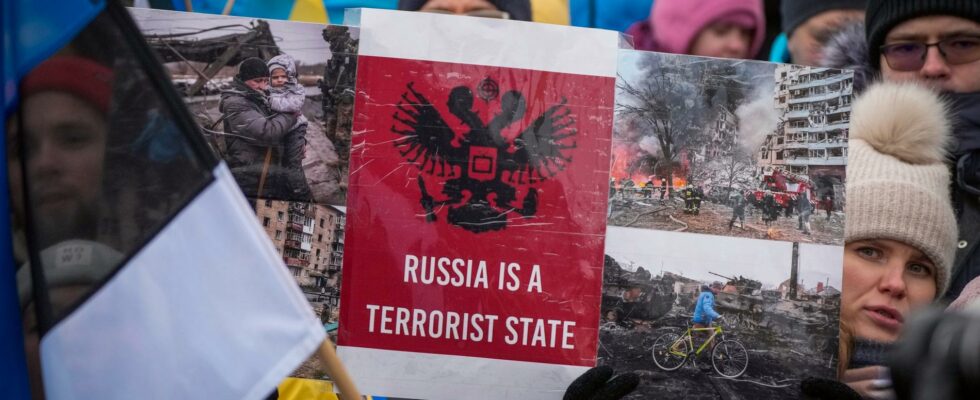Published: Less than 20 min ago
1 of 5 Photo: Sergei Grits/AP/TT
The screams and blows have died down from Estonia’s bloody time under the Soviet Union. But the memories live on – and are given new life by Russia’s war in Ukraine.
The relationship with Moscow is again a major topic as Estonia goes to the polls.
Simple benches and bars for the windows await down in the basement at Bagargatan 1 in Tallinn’s old town.
This is one of Estonia’s most infamous addresses – Pagari 1 in Estonian. From 1940 until 1991, it was here that the Soviet security police brought their detainees.
Some didn’t get much further. Others ended up very far away. In the old prison cells that are now a museum, everything from resistance fighters to schoolgirls who were either executed or sent to Siberia is told.
Tens of thousands of Estonians were deported in double rounds during the 1940s, when the country was forcibly incorporated into the Soviet Union.
Father and daughter
In today’s Estonia, it is no surprise that modern Russia is now increasingly resembling the old Soviet Union.
– We have always had to be afraid of Russia, so it is nothing new. We have gotten used to living in this neighborhood, says former Prime Minister and EU Commissioner Siim Kallas inside the Estonian parliament, riigikogu.
Like the other members, he is in the middle of the electoral spurt ahead of Sunday’s parliamentary elections. For him, it is also of extra family interest. His daughter Kaja is Estonia’s prime minister and the clear favorite to continue ruling after the election.
Both father and daughter belong to the liberal Reform Party, which Siim Kallas himself founded in the early 1990s. Although he emphasizes that it is now the daughter who decides.
– I don’t have much influence over her. She is very independent, laughs Kallas.
Popular leader
Estonia’s government has been one of the EU’s toughest voices against Russia during the war in Ukraine. Kaja Kallas has been extensively written about and celebrated in Brussels, where some even want to see her as the next Secretary General of NATO after Jens Stoltenberg.
At home, however, she is accused by the far-right party Ekre of sending too much aid to Ukraine and thereby endangering her own security.
The other major opposition party, the Center, states in turn that one cannot only talk about weapons and Russia, in a situation when Estonia has one of the EU’s worst inflation rates, around 20 percent.
– Safety is of course an important issue, but we also need to take care of our people. We want to increase pensions. We want to lower the VAT on medicine and food. We have many suggestions on how we can improve welfare, says Center politician and former foreign minister Eva-Maria Liimets.
All with all
The parties in Estonia have joined together in different constellations in recent years. Pretty much everyone has ruled with everyone.
Right now, the Reform Party governs together with the conservative Fäderneslandet and the Social Democrats – although as recently as last summer they had an alliance with the Center instead. Which in turn before that was in alliance with Fäderneslandet and Ekre. And the year before that was also in alliance with the Social Democrats.
A similar bargaining is now waiting again, although Siim Kallas flatly rules out a collaboration with Ekre and prefers that the current government can remain in place.
The center and Eva-Maria Liimets are more open most of the time. And she states that Putin’s war in Ukraine is now washing away the party’s long-standing label as a “Russian party”.
– Yes, we have strong support among Russian-speaking Estonians, but they agree with our policy and that Russia is an aggressor and that we should support Ukraine. Those who disagree have already left the party, says Liimets in Tallinn.
Facts
Estonia
Estonia is located on the east coast of the Baltic Sea, has the Gulf of Finland to the north, Russia to the east and Latvia to the south. The country is slightly smaller than Jämtland County and has approximately 1.4 million inhabitants, of which approximately 450,000 live in the capital Tallinn.
After centuries under Danish, German, Swedish and Russian rule, Estonia became an independent republic after the First World War. During and after the Second World War, they were forced into the Soviet Union, from which they broke free again only in 1991.
Estonia has been a member of both the EU and NATO since 2004 and has had the euro as its currency since 2011. The president since October 2021 is Alar Karis (born 1958), although most of the power lies with the government, with Prime Minister Kaja Kallas (born 1977) at the helm.
Read moreFacts
The election in Estonia
Estonia holds elections for the Riigikogu on Sunday. 75 of the 101 mandates are distributed via twelve constituencies across the country, while the last 26 are equalization mandates to the parties that received at least five percent of the vote.
Since June, the country has been governed by a three-party government between the liberal Reform Party (Reformierakond, 34 seats), the Christian-democratic Fäderneslandet (Isamaa, 11 seats) and the Social Democrats (SDE, 9 seats).
The Riigikogu currently also includes the Center Party (Keskerakond, 23 seats), the far-right Conservative People’s Party (Ekre, 19 seats) and five formally unaffiliated members, including one from the newly formed Right (Parempoolsed).
The Greens (EER), liberal Estonia 200 and the United Left (EÜV/Olpe) also participate in this year’s elections.
Read more
